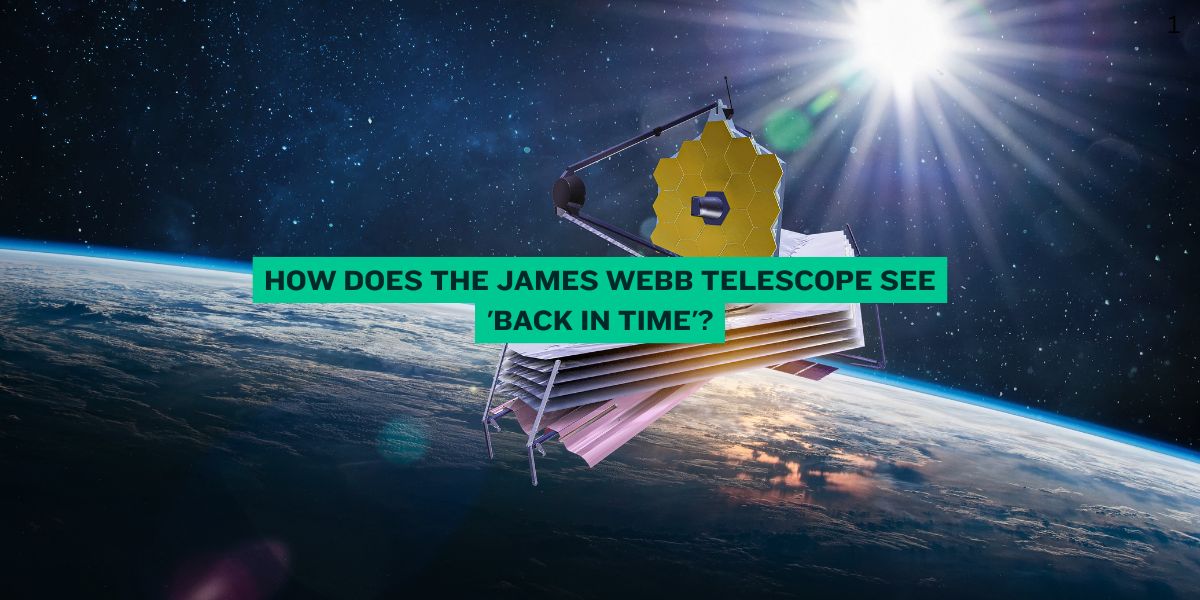Have you ever wished you could travel back in time? While we can’t build a time machine (yet!), scientists have something almost as cool, the James Webb Space Telescope (JWST)! This incredible telescope doesn’t just take pictures of stars and galaxies. It actually lets us see the past!
But how? The answer lies in light. Light from distant stars and galaxies takes billions of years to reach us. When the JWST looks at these faraway objects, it’s seeing them as they were long ago. It’s like looking at an old photograph, the image shows how things were, not how they are now.
So, how far back can the JWST see? And what secrets from the early universe is it uncovering? Let’s find out!
How Does Light Help Us See the Past?
Light travels super fast, 300,000 kilometers per second! But space is so huge that even at this speed, light from distant stars takes a long time to reach us.
- Example: The Sun’s light takes 8 minutes to reach Earth. So, when you look at the Sun, you’re seeing it as it was 8 minutes ago!
- Fun Fact: Some stars are so far away that their light takes thousands of years to reach us. If one of those stars exploded today, we wouldn’t know until its light arrived!
The JWST captures this ancient light, letting us peek into the universe’s history.
Why Is the James Webb Telescope So Powerful?
The JWST is the most advanced space telescope ever built. Here’s why it’s special:
- Big Mirror: Its gold-coated mirror is 6.5 meters wide, much bigger than Hubble’s! A bigger mirror means it can collect more light from faint, distant objects.
- Infrared Vision: Unlike our eyes (which see visible light), the JWST sees infrared light. This helps it spot old, red-shifted light from the early universe.
- Super Cold: The telescope stays super cold (around -223°C) so its own heat doesn’t interfere with the faint infrared signals.
Because of these features, the JWST can see farther back in time than any other telescope!
How Far Back in Time Can the JWST See?
The JWST can see over 13 billion years into the past! That’s close to the beginning of the universe (which is about 13.8 billion years old).
- First Galaxies: The telescope has spotted some of the oldest galaxies ever seen, formed just 200-300 million years after the Big Bang!
- Baby Stars: It also observes young stars and planets forming in dusty space clouds, helping us learn how solar systems (like ours) are born.
Imagine looking at a baby picture of the universe, that’s what the JWST is doing!
What Has the JWST Discovered So Far?
Since its launch in 2021, the JWST has made amazing discoveries:
Oldest Known Galaxy: Found a galaxy that existed just 290 million years after the Big Bang!
Water on Distant Planets: Detected water vapor in the atmosphere of a faraway planet.
Dying Stars: Captured stunning images of dying stars throwing off gas and dust.
Every new image teaches us more about how the universe began and changed over time.
Could the JWST See the Big Bang?
Sadly, no. The Big Bang happened 13.8 billion years ago, but the universe was too hot and dense for light to travel freely at first.
- First Light: The earliest light we can see is the Cosmic Microwave Background (CMB), which came 380,000 years after the Big Bang.
- JWST’s Limit: The telescope sees farther than Hubble, but it can’t see the very first moments of the universe.
Still, it’s giving us the closest look ever at the early cosmos!
A Time Machine in Space!
The James Webb Telescope is like a time machine, letting us see the universe as it was billions of years ago. From baby galaxies to dying stars, every discovery helps us understand how everything began.
Who knows what else the JWST will find? Maybe one day, it will spot something no one expected!
What do YOU think the JWST will discover next? Let us know in the comments!
📌 Frequently Asked Questions
How far can the James Webb Telescope see?
The JWST can see over 13 billion light-years away, showing us galaxies that existed shortly after the Big Bang.
Why is the JWST better than the Hubble Telescope?
The JWST has a larger mirror and sees infrared light, allowing it to spot older, more distant objects than Hubble.
Can the JWST see planets in other galaxies?
Not yet. It mostly sees stars and galaxies, but it has studied planets in our own galaxy in great detail.
How long will the JWST last?
Scientists hope it will work for 10-20 years, depending on fuel and equipment conditions.
Does the JWST take color pictures?
Yes! But since it sees infrared light (invisible to us), scientists add colors to make the images easier to understand.
How cold is the JWST?
The telescope operates at -223°C (-370°F) to avoid interfering with faint infrared signals.
Has the JWST found life?
Not yet, but it has found water and organic molecules on distant planets—key ingredients for life!
How big is the JWST?
Its mirror is 6.5 meters (21 feet) wide, and its sunshield is tennis-court-sized!
Where is the JWST located?
It orbits the Sun, 1.5 million km (1 million miles) from Earth, at a spot called L2.
Can the JWST see black holes?
Yes! It has observed supermassive black holes in distant galaxies by detecting their effects on nearby stars and gas.
